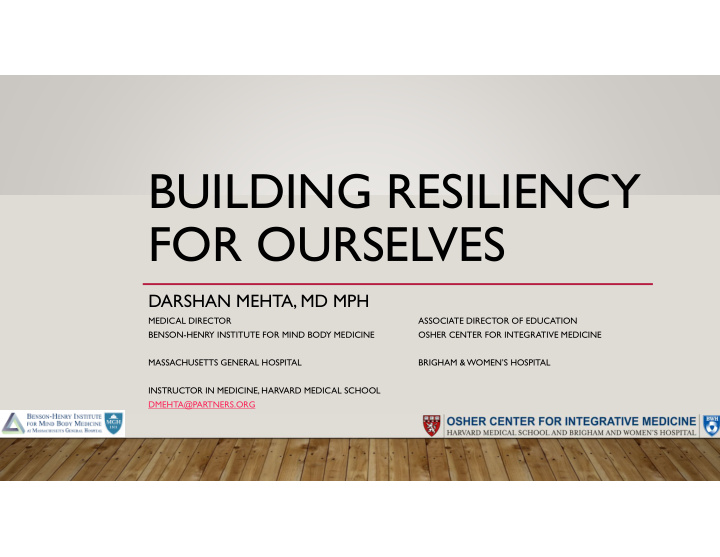



BUILDING RESILIENCY FOR OURSELVES DARSHAN MEHTA, MD MPH MEDICAL DIRECTOR ASSOCIATE DIRECTOR OF EDUCATION BENSON-HENRY INSTITUTE FOR MIND BODY MEDICINE OSHER CENTER FOR INTEGRATIVE MEDICINE MASSACHUSETTS GENERAL HOSPITAL BRIGHAM & WOMEN’S HOSPITAL INSTRUCTOR IN MEDICINE, HARVARD MEDICAL SCHOOL DMEHTA@PARTNERS.ORG
WHAT IS THE WOUNDED HEALER? • Carl Jung • The Archetype of the Wounded Healer • Overcome the pain of our own suffering by becoming compassionate teachers and show others how they too can transcend their own pain • Transcend our suffering through the path of service leading them to help others • See this suffering in others and they can therefore lead others to find ways to overcome their own suffering • Help heal the wider ailments of humanities shared life, but our wounds may not fully heal
WOUNDED HEALER
CONSEQUENCES OF HEALTHCARE PROVIDER BURNOUT Shanafelt and Noseworthy, 2017
CONSEQUENCES OF HEALTHCARE PROVIDER BURNOUT National Academy of Medicine Initiatives
DISCOVERING MY PERSONAL JOURNEY HELPLESSNESS CREATING NEW MEANING
POWER OF RITUAL CREATING THE MEANING IN ADVERSITY
POWER OF RITUAL
WHY NOW? • If skills to prioritize values, and to determine a personal philosophy that integrates professional, personal and spiritual domains are not honed in training, such balance will not easily occur later in one’s career. (Quill, 1990)
PRESENT REALITY
RELAXATION RESPONSE • Initially described by Dr. Herbert Benson in mid-1970s • Conditions by which it is evoked • The repetition of a word, sound, prayer, thought, phrase or muscular activity • The passive return to the repetition when other thoughts intrude • Breaks the train of everyday thought • Benefits seen when performed 15-20 minutes 1-2x/day
RELAXATION RESPONSE • State which is elicited by many mind-body practices, including meditation, tai chi, and yoga • Conceptually the opposite of the stress response • Accompanied by physiological changes include: • Decreased heart rate • Decreased blood pressure • Decreased respiratory rate • Increased exhaled nitric oxide
Dusek, Minn Med . 2009
• > 1500 differentially regulated genes • Decreases in inflammatory pathways • Improved insulin utilization • Increased ATP synthase/mitochondrial energy production MEDITATION CHANGES GENE EXPRESSION Dusek, PLoS ONE, 2008 Bhasin, PLoS ONE , 2013
ELICITING THE RELAXATION RESPONSE IMPACTS… …Apoptosis …Inflammation …Stress Response Dusek JA et al. 2008. PLoS ONE 3:e2576
MEDITATION CHANGES BRAIN STRUCTURE • Regions of the brain affected involve • cognition & executive function • emotion regulation • neurotransmitter release Holzel BK, Psychiatry Res. 2011.
A NEW PARADIGM OF HEALTH Overall Health Surgery Pharmaceuticals Self-care
BENSON-HENRY INSTITUTE FOR MIND BODY MEDICINE AT MASSACHUSETTS GENERAL HOSPITAL • Independent thematic center at MGH • Clinical practice, research and education • Study ways to combat stress and enhance resiliency • Focus on mind body practices in the healthcare system: • Meditation • Yoga • Tai chi
PILLARS OF FINDING MEANING “IT TURNS OUT HAPPINESS IS OVERRATED” Adapted from 2017 TED talk given by Emily Esfahani Smith
PILLAR 1: BELONGING
PRACTICING GIVING AND RECEIVING PRESENCE If you love someone, the greatest gift you can give them is your presence. ― Thích Nhất Hạnh
PILLAR 2: PURPOSE
PILLAR 3: TRANSCENDENCE
MINDFUL AWARENESS • To become more aware of one's own mental processes, listen more attentively, become flexible, and recognize bias and judgments, and thereby act with principles and compassion • To have an ability to observe the observed while observing the observer in the consulting room • Mindful practice requires mentoring and guidance Epstein RM. Mindful Practice . JAMA. 1999; 282: 833-839
PILLAR 4: STORYTELLING
WHAT MAKES MEDICINE SO SPECIAL (AND SO DIFFICULT)? • Medicine informs and transforms not only the patient, but also the provider • Meaning and values underlie professional behavior and commitment • Integrating professionalism into personal identity requires a safe learning environment • Healthcare providers often have a genuine commitment to healing and service
IN GRATITUDE Please Reach Out: Darshan Mehta dmehta@partners.org 617-643-6046
Recommend
More recommend